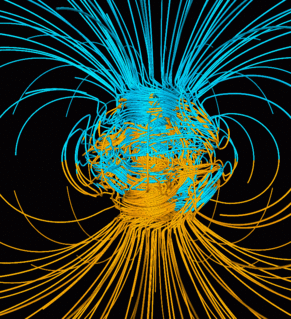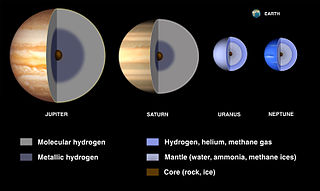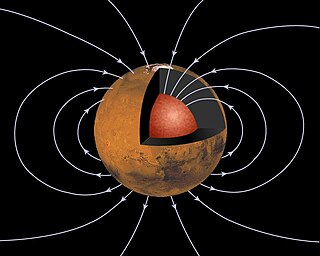
Geophysics is a subject of natural science concerned with the physical processes and physical properties of the Earth and its surrounding space environment, and the use of quantitative methods for their analysis. The term geophysics sometimes refers only to solid earth applications: Earth's shape; its gravitational and magnetic fields; its internal structure and composition; its dynamics and their surface expression in plate tectonics, the generation of magmas, volcanism and rock formation. However, modern geophysics organizations and pure scientists use a broader definition that includes the water cycle including snow and ice; fluid dynamics of the oceans and the atmosphere; electricity and magnetism in the ionosphere and magnetosphere and solar-terrestrial physics; and analogous problems associated with the Moon and other planets.

Earth's magnetic field, also known as the geomagnetic field, is the magnetic field that extends from Earth's interior out into space, where it interacts with the solar wind, a stream of charged particles emanating from the Sun. The magnetic field is generated by electric currents due to the motion of convection currents of a mixture of molten iron and nickel in Earth's outer core: these convection currents are caused by heat escaping from the core, a natural process called a geodynamo. The magnitude of Earth's magnetic field at its surface ranges from 25 to 65 μT. As an approximation, it is represented by a field of a magnetic dipole currently tilted at an angle of about 11° with respect to Earth's rotational axis, as if there were an enormous bar magnet placed at that angle through the center of Earth. The North geomagnetic pole actually represents the South pole of Earth's magnetic field, and conversely the South geomagnetic pole corresponds to the north pole of Earth's magnetic field. As of 2015, the North geomagnetic pole was located on Ellesmere Island, Nunavut, Canada.

In physics, the dynamo theory proposes a mechanism by which a celestial body such as Earth or a star generates a magnetic field. The dynamo theory describes the process through which a rotating, convecting, and electrically conducting fluid can maintain a magnetic field over astronomical time scales. A dynamo is thought to be the source of the Earth's magnetic field and the magnetic fields of Mercury and the Jovian planets.

Paleomagnetism, or palaeomagnetism, is the study of the record of the Earth's magnetic field in rocks, sediment, or archeological materials. Magnetic minerals in rocks can lock-in a record of the direction and intensity of the magnetic field when they form. This record provides information on the past behavior of Earth's magnetic field and the past location of tectonic plates. The record of geomagnetic reversals preserved in volcanic and sedimentary rock sequences (magnetostratigraphy) provides a time-scale that is used as a geochronologic tool. Geophysicists who specialize in paleomagnetism are called paleomagnetists.

A planetary core consists of the innermost layers of a planet. Cores may be entirely solid or entirely liquid, or a mixture of solid and liquid layers as is the case in the Earth. In the Solar System, core sizes range from about 20% to 85% of a planet's radius (Mercury).
The Brunhes–Matuyama reversal, named after Bernard Brunhes and Motonori Matuyama, was a geologic event, approximately 781,000 years ago, when the Earth's magnetic field last underwent reversal. Estimations vary as to the abruptness of the reversal. A 2004 paper estimated that it took over several thousand years; a 2010 paper estimated that it occurred more quickly, perhaps within a human lifetime; a 2019 paper estimated that the reversal lasted 22,000 years.
A geomagnetic reversal is a change in a planet's magnetic field such that the positions of magnetic north and magnetic south are interchanged. The Earth's field has alternated between periods of normal polarity, in which the predominant direction of the field was the same as the present direction, and reverse polarity, in which it was the opposite. These periods are called chrons.

Earth's inner core is the innermost geologic layer of planet Earth. It is primarily a solid ball with a radius of about 1,220 km (760 mi), which is about 20% of Earth's radius or 70% of the Moon's radius.

The Australasian strewnfield is the youngest and largest of the tektite strewnfields, with recent estimates suggesting it may cover 10%–30% of the Earth's surface. Research indicates that the impact forming the tektites occurred around 790,000 years ago, probably in Southeast Asia.
The Gauss–Matuyama Reversal was a geologic event approximately 2.58 Ma when the Earth's magnetic field underwent a geomagnetic reversal from normal polarity to reverse polarity. The reversal is named after German physicist Johann Carl Friedrich Gauss and Japanese geophysicist Motonori Matuyama.

Antoine Joseph Bernard Brunhes was a French geophysicist known for his pioneering work in paleomagnetism, in particular, his 1906 discovery of geomagnetic reversal. The current period of normal polarity, Brunhes Chron, and the Brunhes–Matuyama reversal are named for him.

Motonori Matuyama was a Japanese geophysicist who was the first to provide systematic evidence that the Earth's magnetic field had been reversed in the early Pleistocene and to suggest that long periods existed in the past in which the polarity was reversed. He remarked that the Earth's field had later changed to the present polarity. The era of reversed polarity preceding the current Brunhes Chron of normal polarity is now called the Matuyama Reversed Chron; and the transition between them is called the Brunhes–Matuyama or Matuyama-Brunhes reversal.
The Jaramillo reversal was a reversal and excursion of the Earth's magnetic field that occurred approximately one million years ago. In the geological time scale it was a "short-term" positive reversal in the then-dominant Matuyama reversed magnetic chronozone; its beginning is widely dated to 990,000 years before the present (BP), and its end to 950,000 BP.

The biological and geological future of Earth can be extrapolated based on the estimated effects of several long-term influences. These include the chemistry at Earth's surface, the cooling rate of the planet's interior, the gravitational interactions with other objects in the Solar System, and a steady increase in the Sun's luminosity. However, an uncertain factor is the continuous influence of technology introduced by humans, such as climate engineering, which could cause significant changes to the planet. For example, the current Holocene extinction is being caused by technology. The effects may last for up to five million years. In turn, technology may result in the extinction of humanity, leaving the planet to gradually return to a slower evolutionary pace resulting solely from long-term natural processes.
Geomagnetic secular variation refers to changes in the Earth's magnetic field on time scales of about a year or more. These changes mostly reflect changes in the Earth's interior, while more rapid changes mostly originate in the ionosphere or magnetosphere.
The Laschamp or Laschamps event was a geomagnetic excursion. It occurred between 42,200 and 41,500 years ago, during the end of the Last Glacial Period. It was discovered from geomagnetic anomalies found in the Laschamps lava flows in Clermont-Ferrand, France in the 1960s.
Magnetic field reversal may refer to:

The magnetic field of Mars is the magnetic field generated from Mars' interior. Today, Mars does not have a global magnetic field. However, Mars did power an early dynamo that produced a strong magnetic field 4 billion years ago, comparable to Earth's present surface field. After the early dynamo ceased, a weak late dynamo was reactivated ~3.8 billion years ago. The distribution of Martian crustal magnetization is similar to the Martian dichotomy. Whereas the Martian northern lowlands are largely unmagnetized, the southern hemisphere possesses strong remanent magnetization, showing alternating stripes. Our understanding of the evolution of the magnetic field of Mars is based on the combination of satellite measurements, Martian ground-based magnetic data, paleomagnetic analysis of meteorites, planetary thermal evolution modeling, and magnetohydrodynamic simulations.










